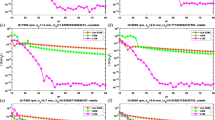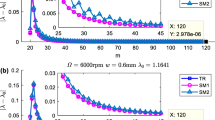Abstract
Stability lobe diagrams (SLDs) can be employed to determine the stability behavior of a milling process. Hence, SLD recognition is an important issue for an effective stable machining monitoring system. Various methods have been developed for prediction of milling stability. However, the main shortcoming of such methods is that they cannot accurately and efficiently predict milling stability. This study proposes a novel precise integration-based updated numerical integration method (PI-UNIM) that can be both accurate and efficient in milling stability prediction. The fifth-order Hermite interpolation polynomial for numerical integration formula derivation is addressed in this work. Transition matrix is obtained with the precise integration algorithm. The numerical results obtained using extensive simulation indicate that the proposed method can effectively recognize SLDs for not only low immersion milling situation but also high immersion milling situation. Empirical comparisons show that the proposed method performs better than existing methods in terms of computation accuracy and computation efficiency. A demonstrative example is provided to illustrate the usage of the proposed method.





Similar content being viewed by others
Data availability
The data associated with this study is publicly accessible on request.
Code availability
The source code implemented in Matlab available on request.
References
Sridhar R, Hohn R, Long G (1968) A stability algorithm for the general milling process. J Eng Ind-T ASME 90:330–334
Tlusty J, Ismail F (1983) Special aspects of chatter in milling. J Vib Acoust Stress Reliab Des-T ASME 105:24–32
Smith S, Tlusty J (1993) Efficient simulation programs for chatter in milling. CIRP Ann-Manuf Techn 42:463–466
Davies M, Pratt J, Dutterer B, Burns T (2002) Stability prediction for low radial immersion milling. J Manuf Sci E-T ASME 124:217–225
Campomanes M, Altintas Y (2003) An improved time domain simulation for dynamic milling at small radial immersions. J Manuf Sci E-T ASME 125:416–422
Altintas Y, Weck M (2004) Chatter stability of metal cutting and grinding. CIRP Ann-Manuf Techn 53:619–642
Altintaş Y, Budak E (1995) Analytical prediction of stability lobes in milling. CIRP Ann Manuf Technol 44(1):357–362
Merdol SD, Altintas Y (2004) Multi frequency solution of chatter stability for low immersion milling. J Manuf Sci Eng-Trans ASME 126(3):459–466
Bayly P, Halley J, Mann B, Davies M (2003) Stability of interrupted cutting by temporal finite element analysis. J Manuf Sci Eng-Trans ASME 125(2):220–225
Insperger T, Stépán G (2004) Updated semi-discretization method for periodic delay-differential equations with discrete delay. Int J Numer Methods Eng 61(1):117–141
Insperger T, Stépán G, Turi J (2008) On the higher-order semi-discretization for periodic delayed systems. J Sound Vib 313(1–2):334–341
Altintas Y, Chan P (1992) In-process detection and suppression of chatter in milling. Int J Mach Tools Manuf 32(3):329–347
Insperger T, Stepan G (2004) Stability analysis of turning with periodic spindle speed modulation via semidiscretization. J Vib Control 10(12):1835–1855
Long X, Balachandran B (2010) Stability of up-milling and down-milling operations with variable spindle speed. J Vib Control 16(7–8):1151–1168
Ding Y, Niu J, Zhu LM, Ding H (2015) Numerical integration method for stability analysis of milling with variable spindle speeds. ASME J Vib Acoust 138(1):011010–011011
Altıntas Y, Engin S, Budak E (1999) Analytical stability prediction and design of variable pitch cutters. J Manuf Sci Eng 121(2):173–178
Sims N, Mann B, Huyanan S (2008) Analytical prediction of chatter stability for variable pitch and variable helix milling tools. J Sound Vib 317(3–5):664–686
Wan M, Zhang W, Dang J, Yang Y (2010) A unified stability prediction method for milling process with multiple delays. Int J Mach Tools Manuf 50(1):29–41
Ding Y, Zhu L, Zhang X, Ding H (2010) A full-discretization method for prediction of milling stability. Int J Mach Tools Manuf 50(5):502–509
Ding Y, Zhu L, Zhang X, Ding H (2010) Second-order full-discretization method for milling stability prediction. Int J Mach Tools Manuf 50(10):926–932
Quo Q, Sun Y, Jiang Y (2012) On the accurate calculation of milling stability limits using third-order full-discretization method. Int J Mach Tools Manuf 62:61–66
Ji Y, Wang X, Liu Z, Yan Z (2018) An updated full-discretization milling stability prediction method based on the higher-order Hermite-Newton interpolation polynomial. Int J Adv Manuf Technol 95:2227–2242
Huang C, Yang W, Cai X, Liu W, You Y (2020) An efficient third-order full-discretization method for prediction of regenerative chatter stability in milling. Shock Vib 1:1–16
Dai Y, Li H, Yang G, Peng D (2021) A novel method with Newton polynomial-Chebyshev nodes for milling stability prediction. Int J Adv Manuf Technol 112:1373–1387
Li M, Zhang G, Huang Y (2013) Complete discretization scheme for milling stability prediction. Nonlinear Dyn 71(1–2):187–199
Huang T, Zhang X, Ding H (2013) An efficient linear approximation of acceleration method for milling stability prediction. Int J Mach Tools Manuf 74:56–64
Huang T, Zhang X, Ding H (2017) A novel approach with smallest transition matrix for milling stability prediction. Nonlinear Dyn 90:95–104
Ding Y, Zhu L, Zhang X, Ding H (2011) Numerical integration method for prediction of milling stability. J Manuf Sci Eng-Trans ASME 133(3):031005–031009
Zhang Z, Li H, Meng G, Liu C (2015) A novel approach for the prediction of the milling stability based on the Simpson method. Int J Mach Tools Manuf 99:43–47
Ozoegwu CG (2016) High order vector numerical integration schemes applied in state space milling stability analysis. J Appl Math Comput 273:1025–1040
Dong X, Qiu Z (2020) Stability analysis in milling process based on updated numerical integration method. Mech Syst Signal Pr 137:0888–3270
Dai Y, Li H, Xing X, Hao B (2018) Prediction of chatter stability for milling process using precise integration method. Precis Eng-J Int Soc Precis Eng Nanotechnol 52:152–157
Li H, Dai Y, Fan Z (2018) Improved precise integration method for chatter stability prediction of two-DOF milling system. Int J Adv Manuf Technol 101(5–8):1235–1246
Farkas M (1994) Periodic motions. Springer, Berlin
Funding
This study is funded by the Fundamental Research Funds for the Central Universities (NT2021019) and National Natural Science Foundation of China (51775279).
Author information
Authors and Affiliations
Corresponding author
Ethics declarations
Ethical approval
Every ethical requirement has been met and observed.
Consent to participate
Not applicable.
Consent for publication
The editor has our (authors) consent to publish.
Competing interests
The authors declare no competing interests.
Additional information
Publisher's Note
Springer Nature remains neutral with regard to jurisdictional claims in published maps and institutional affiliations.
Rights and permissions
Springer Nature or its licensor (e.g. a society or other partner) holds exclusive rights to this article under a publishing agreement with the author(s) or other rightsholder(s); author self-archiving of the accepted manuscript version of this article is solely governed by the terms of such publishing agreement and applicable law.
About this article
Cite this article
Liu, W., Yang, WA., Chen, Y. et al. A novel precise integration-based updated numerical integration method for milling stability prediction. Int J Adv Manuf Technol 124, 2109–2126 (2023). https://doi.org/10.1007/s00170-022-10372-3
Received:
Accepted:
Published:
Issue Date:
DOI: https://doi.org/10.1007/s00170-022-10372-3




